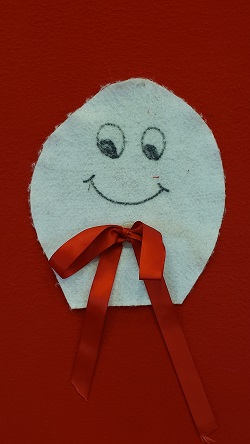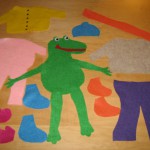So I used my felt pieces for Where’s Spot again last Thursday, this time for a preschool storytime (ages four to seven). I did it partly as an experiment – comparing the reactions of the toddler age group to this age group – and partly because I had a feeling it would be lots of fun.
It was a BLAST! By age four, most kids know this story inside out, and when I brought out a new piece – the grandfather clock, for instance – the kids would start yelling “There’s a snake in there!!!!” And I would play the dumb adult, saying, “Gee, are you sure? You really think there’s a snake in the clock? Don’t you think Spot is in the clock?” And the kids would holler back in unison, “NOOOO!!!! It’s a SNAKE!!!!” And I’d open the the door of the clock and find the snake, and shake my head while saying, “Wow, you guys were right. There IS a snake in there. No Spot, but a snake…”
And then we’d continue on to the next felt piece, and repeat the process. The kids had a fantastic time hollering their thoughts to me (which, surprisingly, never once felt out of control, because I was able to moderate their comments and behavior through the whole story), and I had a great time pretending to be the not-so-bright librarian who had no clue what animal was in each of the felt pieces.
In fact, it was so much fun that I’m going to extend the experiment tomorrow morning, and try using these felt pieces with the infant storytime crowd. Lots of babies, some one year olds, a few twos or almost twos. It will be very, very interesting to observe this crowd and how they react to the story.
Most importantly for my own storytelling, though, last Thursday was a prime example of how the best storytimes are interactive, with the storyteller paying close attention to the reactions of the kids in the audience. If you’re willing and able to “riff” a little when telling stories, it becomes the most incredible experience for everyone, storyteller AND audience. I left last Thursday’s storytime smiling and with a totally happy storytime buzz that lasted me the rest of the day. Hopefully tomorrow’s telling of Where’s Spot will be just as wonderful.






